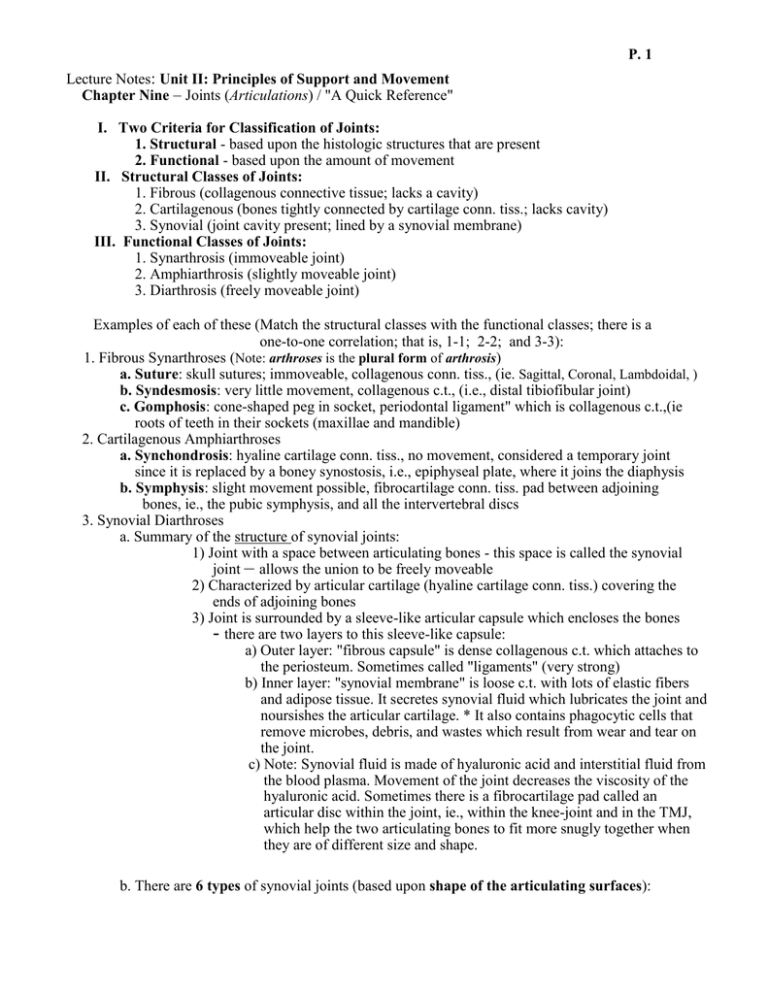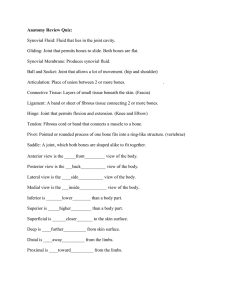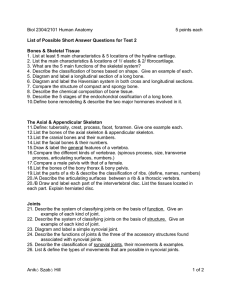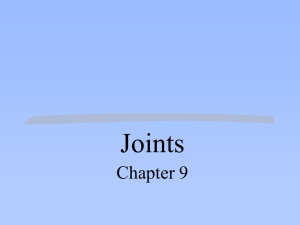: –
advertisement

P. 1 Lecture Notes: Unit II: Principles of Support and Movement Chapter Nine – Joints (Articulations) / "A Quick Reference" I. Two Criteria for Classification of Joints: 1. Structural - based upon the histologic structures that are present 2. Functional - based upon the amount of movement II. Structural Classes of Joints: 1. Fibrous (collagenous connective tissue; lacks a cavity) 2. Cartilagenous (bones tightly connected by cartilage conn. tiss.; lacks cavity) 3. Synovial (joint cavity present; lined by a synovial membrane) III. Functional Classes of Joints: 1. Synarthrosis (immoveable joint) 2. Amphiarthrosis (slightly moveable joint) 3. Diarthrosis (freely moveable joint) Examples of each of these (Match the structural classes with the functional classes; there is a one-to-one correlation; that is, 1-1; 2-2; and 3-3): 1. Fibrous Synarthroses (Note: arthroses is the plural form of arthrosis) a. Suture: skull sutures; immoveable, collagenous conn. tiss., (ie. Sagittal, Coronal, Lambdoidal, ) b. Syndesmosis: very little movement, collagenous c.t., (i.e., distal tibiofibular joint) c. Gomphosis: cone-shaped peg in socket, periodontal ligament" which is collagenous c.t.,(ie roots of teeth in their sockets (maxillae and mandible) 2. Cartilagenous Amphiarthroses a. Synchondrosis: hyaline cartilage conn. tiss., no movement, considered a temporary joint since it is replaced by a boney synostosis, i.e., epiphyseal plate, where it joins the diaphysis b. Symphysis: slight movement possible, fibrocartilage conn. tiss. pad between adjoining bones, ie., the pubic symphysis, and all the intervertebral discs 3. Synovial Diarthroses a. Summary of the structure of synovial joints: 1) Joint with a space between articulating bones - this space is called the synovial joint – allows the union to be freely moveable 2) Characterized by articular cartilage (hyaline cartilage conn. tiss.) covering the ends of adjoining bones 3) Joint is surrounded by a sleeve-like articular capsule which encloses the bones - there are two layers to this sleeve-like capsule: a) Outer layer: "fibrous capsule" is dense collagenous c.t. which attaches to the periosteum. Sometimes called "ligaments" (very strong) b) Inner layer: "synovial membrane" is loose c.t. with lots of elastic fibers and adipose tissue. It secretes synovial fluid which lubricates the joint and noursishes the articular cartilage. * It also contains phagocytic cells that remove microbes, debris, and wastes which result from wear and tear on the joint. c) Note: Synovial fluid is made of hyaluronic acid and interstitial fluid from the blood plasma. Movement of the joint decreases the viscosity of the hyaluronic acid. Sometimes there is a fibrocartilage pad called an articular disc within the joint, ie., within the knee-joint and in the TMJ, which help the two articulating bones to fit more snugly together when they are of different size and shape. b. There are 6 types of synovial joints (based upon shape of the articulating surfaces): P. 2 1) Ball-and-Socket (also called spheroid) a) Rounded head in socket-like fossa, ie, head of femur in acetabulum of hip b) Allows for the most amount of movement (greatest range of motion) c) Examples: hip, shoulder, 1st finger (metacarpal-1st phalangeal joint) 2) Hinge (also called ginglymus) a) Convex surface of one bone fits into concave surface of another bone b) Motion stops at a certain point, ie., just like a hinged-door c) Examples: elbow, knee, TMJ 3) Gliding a) Articulating surfaces of bones are quite flat b) Only side-to-side or back-and-forth motion are possible (referred to as non-axial, as movement is NOT around a single axis) c) Examples: between the carpals and between the tarsals; also, the sternoclavicular joint and claviculoscapular joint 4) Pivot (also called trochoid) a) Rounded, pointed or conical surface of one bone articulates within a ring formed by another bone and its ligament b) The movement permitted is rotation c) Examples: Atlantoaxial joint; also, proximal ends of the radius and ulna 5) Ellipsoidal (also called condyloid) a) An oval-shaped condyle of one bone fits into an elliptical cavity of another bone b) Movements include side-to-side and back-and-forth movements c) Examples: joint at wrist (formed between the radius and ulna (together) superior to the carpals) 6) Saddle (also called sellaris) a) Both articulating bones have saddle-shaped surfaces (are concave in one direction and convex in the other). Saddle joints are modified ellipsoidal joints in which movement is freer b) Movements are side-to-side and back-and-forth, but with greater range of motion c) Example: Metacarpal of the thumb which articulates with trapezium carpal bone. OTHER TERMS: 1. Bursitis: A bursa is a fluid-filled sac found where bone is close to the skin, ie., in the knees, hips and shoulder. These bursa act as a cushion. Bursitis is an inflammation of this bursa sac, usually caused by over-use of the joint resulting in undue strain on the bursa 2. Tendonitis: Inflammation of the tendons and sheaths. A dense fibrous c.t. ribbon which attaches muscle to bone. Very painful. Needs to be treated with cortisone to reduce the inflammation. 3. Dislocations: A condition in which the bone is displaced from its normal position in the joint 4. Sprain: A "twisted joint". Injury to blood vessels, tendons, ligaments are usually included. A P. 3 sprain can be slow to heal and more painful than a break. 5. Scoliosis: Abnormal lateral curvature of any region of the vertebral column. Can be congenital or position related. 6. Lordosis: Abnormal anterior curvature of the lumbar region of the vertebral column. Also called "sway-back". Usually congenital. 7. Kyphosis: Abnormal posterior curvature of the thoracic region of the vertebral column. Also called "hunch-back". Usually congenital; but can be a part of the aging process as one loses muscle tone to hold self erect; thus losing the ability to hold all the vertebrae in place. Kyphosis is exacerbated by osteoporosis. Also, osteoporosis can, and often does, lead to kyphosis. 8. Fontanels: Know these 6 fontanels: (See Pages 210 - 211 of textbook) a. Anterior (unpaired): Largest fontanel; midline between the two parietal bones and the frontal bone; closes at age 18 - 24 months. b. Posterior (unpaired): Midline between the two parietal bones and the occipital bone; closes at age 2 months. c. Anterolateral (paired): Bilateral between the frontal, parietal, temporal, and sphenoid bones; close at age 3 months. d. Posterolateral (paired): Bilateral between the parietal, temporal, and occipital bones; closure begins at age 1-2 months but not complete until age 1 year.




